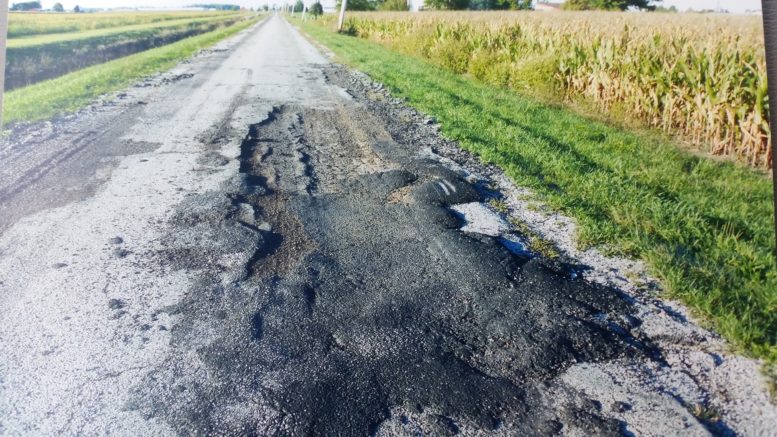By JAN LARSON McLAUGHLIN
BG Independent News
Wood County Engineer John Musteric is tired of just spinning his wheels on endless road and bridge repairs. So on Thursday, he asked the Wood County Commissioners to consider tacking on another $5 permissive license plate fee to raise money for road and bridge maintenance.
The commissioners seemed open to the proposal.
“He’s done his homework,” Commissioner Doris Herringshaw said. “Our roads and bridges do need some attention.”
The commissioners will be required to hold two public hearings before they make a decision on the permissive license fee.
But Commissioner Craig LaHote said he believes most local residents already know the county’s infrastructure needs help. “People realize the roads are in bad shape,” he said.
Musteric and the commissioners looked at a map of county roads – with several of the routes colored red or orange, indicating serious or poor road conditions.
“We’re never catching up,” Musteric told the commissioners. “We do all these studies of where we should put our money. You try to spend your money where the most people will benefit from it.”
The county engineer feels his office is in a Catch-22 situation. What’s the use of spending money to fix bridges, he said, “if you’ve got crappy roads going to them?”
Wood County Administrator Andrew Kalmar said state and federal government have “no appetite” for raising gas taxes themselves. And the revenue brought in by gas taxes isn’t growing to meet expenses, since more fuel-efficient cars mean less gas is needed to traverse the state.
“It makes the revenue generated remain flat,” Kalmar said.
The proposed $5 increase is projected to bring in an additional $632,660 annually for road and bridge repairs. Musteric pledged to the commissioners that the additional funds would be used only on capital expenses, not on personnel or operating costs.
Currently the state registration fee is $34.50, and the local permissive fees are between $15 and $20, depending on the community.
The Ohio General Assembly has authorized the additional $5 fee.
“They recognized the stagnant funding of local transportation systems and that counties were struggling to keep up with the need for bridge replacements and road repair,” Musteric said.
The federal gas tax has not been increased since 1993, and the state gas tax has not been increased since 2005. Ohio gas tax is currently 28 cents, and the federal gas tax is 18.4 cents.
The last county $5 permissive fee was enacted in 1990.
Meanwhile, the cost of building and maintaining roads has continued to grow. Since the last state gas tax increase, the cost of asphalt has jumped 58 percent, steel has increased 35 percent, concrete has gone up 10 percent, and road paint has jumped 38 percent.
To deal with stagnant or declining revenue and rising costs, some counties have enacted county road and bridge levies. Wood County has not. Some counties have dedicated a portion of their sales tax revenue for roads and bridges. Wood County has not.
“You can see with all of the costs, we’re behind the 8-ball,” Musteric said.
According to Musteric, the county engineer’s office has tried to do more with less. The office has reduced the number of employees from 52 in 2006 to 44 in 2018. He is also trying to turn over some of the smaller roads to township maintenance, and transfer bridges inside municipalities to their care.
“I’m always looking at ways to cut costs and get additional money. I really think we should do this,” he said to the commissioners about the $5 license fee.
Musteric said the county is in an impossible position of catching up on road and bridge repairs. Following are some statistics about county bridges:
- County owns and maintains 441 bridges.
- Average age of the bridges is 41 years old.
- Bridges 50 years old or more: 149.
- Bridges 75 years old or more: 68.
- Bridges 100 years old or more: 21.
- Bridges in poor or worse shape: 52.
- Oldest bridge in county: 133 years old.
Bridge repairs and replacements don’t come cheap. The average bridge replacement costs $400,000. The cost to replace all the county’s bridges in poor or worse condition is estimated at $20.8 million.
The average number of bridges replaced in one year is 4.5. To keep up with maintenance, the county should be replacing nine a year, Musteric said.
The status of county roads isn’t much better, with 74 percent rated in marginal or worse condition.
- County has 245 miles of roads it must maintain.
- Rated as “good” are 12 miles of roadway.
- Rated “fair” are 52 miles.
- Rated “marginal” are 64 miles.
- Rated “poor” are 79 miles.
- Rated “serious” are 38 miles.
The estimated cost to bring all county roads to at least “fair” condition is $39 million. Repairing a mile of road can be costly. A mile of chip seal is $15,000; and mile of microsurfacing is $40,000; and a mile of hot mix asphalt is $85,000.
To keep up with road repairs, the engineer’s office should be spending about $2.3 million a year. But the office is budgeting $1.1 million a year.
The engineer’s office revenue comes from state and federal gas tax ($2.4 million a year), license plate fees ($4.3 million a year), fines from highway offenses ($168,000 a year), and county gas tax ($800,000 a year).





